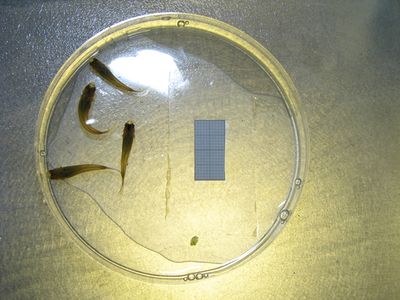This site is being phased out.
Measuring length of fish in petri dish
This image analysis example came from a genetics researcher:
"My aim is to measure the standard length of fish in the petridish. Standard length being defined as the distance between the tip of the snout to the last vertebrae and excludes tail area. The millimetre scale on the picture is to convert pixels to millimetres.
By high contrast in the pictures, I should be able to exclude tail area from the measurable pixels. I am uncertain however how to convert pixels to millimetres using the Pixcavator program."
The analysis results from Pixcavator are below.
Calibration can be done only manually. I analyzed the image after shrinking it by 6x (default), for the quickness sake. The analysis produced several objects and one of them is the rectangular scale. According to the Pixcavator's output table, its area is 3499 pixels. Its real area is
10*20 = 200 sq. mm. So, 1 sq. pixel = 200/3499 = .057 sq. mm, so 1 (length) pixel is the square root of that, or .24.
This is the scaling factor. So, if one of the fishes is shown as 46 pixels long then its real length is 46*.24 = 11 mm. Certainly, the fishes can be captured better.
Run this analysis with Pixcavator SI.
Other image analysis examples

